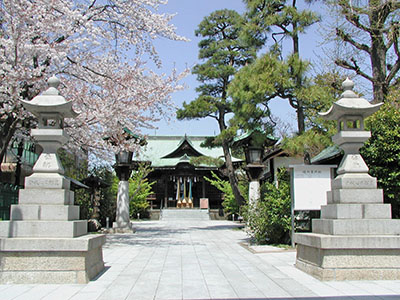Sakura Jingū Association
The Association was built to enhance the spirit of the deities by thanking them and our ancestors, and to offer a 'healing' and 'connecting’ place, aiming to make people's daily life peaceful, Members of the association have many benefits including a protective talisman offered anually our newsletter subscription, opportunities to pray in the sanctum, participation in meditation before kami, and wedding ceremonies and funerals. Join the association that connects you and the deities of Sakura Jingū. For inquiries, please call Sakura Jingū
office on 03-3429-0869
Yoshimura Masamochi, the 65th descendant of Ōnakatomi, was a warrior of the imperial loyalists in Kyoto. During the early Meiji period, he worked at the Department of Shinto Affairs (which later became the Ministry of Religious Education), and took part in policy making for Shinto propagation under the government. Served as chief priest of a shrine, he devoted himself into spreading the teachings of Shinto.
However, when the Meiji government suddenly altered their religious policy, Masamochi decided that it was his mission to lead people to the traditional Shinto values. He founded a religious organization and established a religious facility (a shrine) in Kanda. It became an independent sect called Shinshu-kyō, sanctioned by the Meiji Emperor in 1882.
Masamochi, who was highly favored by Saigo Takamori and Ito Hirobumi as well as other key government officials, spent time with Percival Lowell, an American astronomer and a devout Christian, and taught him Shinto beliefs during his stay in Japan. Introduced by the Ministry of Foreign Affairs and the books of Lowell, more than 200 Westerners visited annual festivals at the shrine during the Meiji period. Masamochi received an oracle just before his death, which resulted in the relocation of the shrine to the current location in the early Taisho period.
The mirror (mikagami) of Chrysanthemum of 16 petals is the object of worship. The mirror was enshrined in Edo castle during the Edo period before the buildings of shrine in the castle was destroyed by a fire. After approved by the Imperial court, the mirror was then enshrined in Shin- mei-gū shrine by Keikōin in Reigan-jima island in Fukagawa, Tokyo. The mirror was moved again to a Grand Shrine after the Meiji Restoration. The then supreme priest of the shrine, kuninomiya Asahiko Shinnō (Prince), who confided Masamochi, he himself divided the spirit of the enshrined deity of the Grand Shrine to the mirror, which was then granted to the shrine when Masamochi left his post.
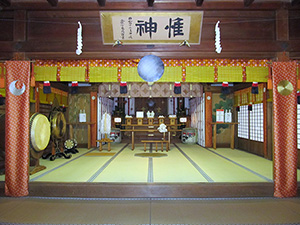
| Shihōhai (January 1st) |
Celebration of the New Year, worshipping the deities in all four directions. |
|---|---|
| Genshi-sai (January 3rd) |
Celebration of the descent of Ninigi (grandson of Amaterasu, the goddess of the sun) to earth. |
| Yoshimura Masamochi-sai (January 21st) |
Celebration of Yoshimura Masamochi' s life. |
| Setsubun-sai (February 3rd) |
Celebration of the coming of spring |
| Taisai (April 9th) |
Great festival. |
| Nagoshi no Ōharai (June 30th) |
Great purification |
| Chusai (September 17th) |
Middle festival. |
| Irei taisai (Second Sunday of July) |
Great memorial service. |
| Toshikoshi Ōharai (December 27th) |
Monthly ceremonies. |
| Tsukinami-sai (9th, 21st, and 27th of every month) |
Monthly ceremonies. |
| Kitō-sai (17th of every month) |
Ceremony to pray for safety. |
Godō jigoku shiki, or Kamanari (The purifying sound of iron pot)
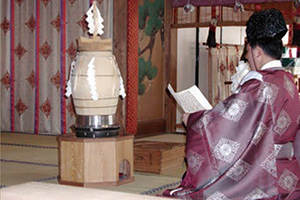
The sound that iron pot filled with cooked rice makes during the ritual in front of kami. This sound purifies the defilements (tsumi and kegare) of each individual. This ceremony is held on April 9, June 30, September 17, and December 27.
Chinka shiki (The fire calming ceremony)
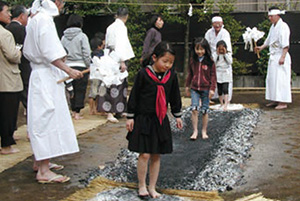
The ritual of 'pacifying fire’ by walking barefoot on the bed of 6 meters long red-hot charcoal embers. Participants circumambulate the walkway, where salt is spread on the coals after purification. This ceremony is held on April 9.
Kugatachi shiki or Yutate (The sprinkling of boiling water on the body)
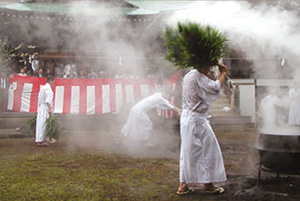
A ritual in which the priest dips bamboo fronds into boiling water and sprinkles on the body. This ceremony is held on September 17.
"Remote" Worship is available for those who live abroad or in a remote place, or those who are unable to come due to their work or health issues, by simply following the guide on our website. We offer inquiries and consultation services as well.
■HOMEPAGE ADDRESShttps://www.sakura.jingu.net/
SAKURA JINGŪ
3-21, SHINMACHI, SETAGAYA-KU,TOKYO 154-0014 JAPAN [→google MAP]
Tel 81-3-3429-0869
Fax 81-3-3429-7452
URL http://www.sakura.jingu.net
E-mail info@sakura.Jingu.net
3-21, SHINMACHI, SETAGAYA-KU,TOKYO 154-0014 JAPAN [→google MAP]
Tel 81-3-3429-0869
Fax 81-3-3429-7452
URL http://www.sakura.jingu.net
E-mail info@sakura.Jingu.net

(1)Tokyu Den-en-toshi Line Sakura-shimmachi Station Ticket Gate
▼

(2)Sakura-shimmachi Station North Exit
▼
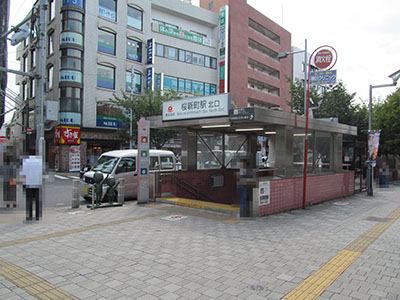
(3)Sakura-Shimmachi Station North Exit (Appearance from outside)
▼

(4)Walk Straight from the North Exit
▼

(5)You will see Family Mart and Sakura Kindergarden as a landmark
▼
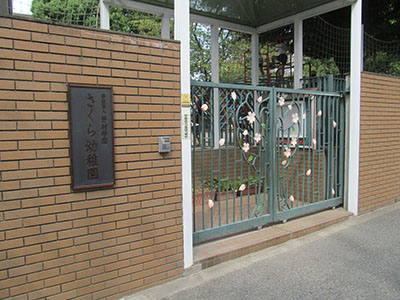
(6)Keep walking until you pass the Kindergarden's entrance gate
▼
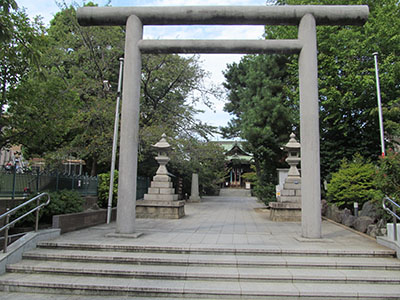
(7)There, you will see Sakurajingu's Torii

